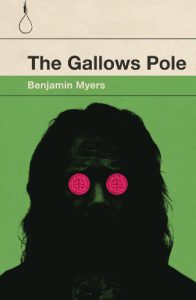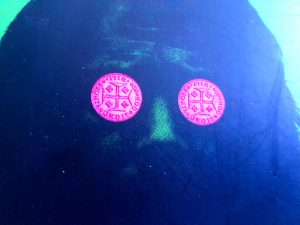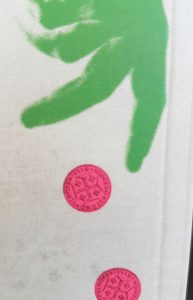
WORDS: Gareth E. Rees
LOCATION: Yorkshire
Benjamin Myers’ The Gallows Pole [Bluemoose Books] is a novel about the Cragg Vale Coiners, a band of forgers led by David Hartley in the 18th Century.
The Gallows Pole opens with a taxonomy of the terrain as a boy named Jack Bentley wends his way towards the stronghold of the Cragg Vale Coiners:
“Soot and ash. Snot and spume.
Quag and sump and clotted moss.
Loam.
The boy left the river and the village behind him and he felt the valley narrow and tighten as he turned up the track and the trees curled in around him and over him. Pulled him in.
In to dell and dingle. Gulch and gully. Mulch and algae. England.”
The terms in those first lines are loaded with history…
…Quag, a 16th Century word for a boggy place.
…Sump, a Middle English word for a pit where water collects.
…Loam, an Old English for a mixture of sand, silt, and clay.
…Spume, an old word for ‘froth’ or ‘foam’.
Such words are cultural roots for the rural people of 18th Century Yorkshire. They hold firm their myths. They define their relationship with their locale. They are signifiers of resistance against invading industrialist forces which threaten their way of life.
For what an urban interloper might see simply as mud and vegetation, the locals see as phenomena with myriad differentiations. Each undulation and texture has not only a name and meaning but a purpose too. For only those who truly know this landscape can walk it safely and uncover the secrets of the Cragg Vale Coiners.
“To most the bog looked like any other patch of moor but David Hartley and those who lived close by knew it was deadly.”
Jack Bentley has such an understanding and for that he is rewarded with an acquiescent terrain. As he moves up the valley, trees curl and pull him in, much like a story draws in a reader. In the act of walking Jack ‘reads’ the story of the place. [“Mind where you put your bloody feet,” he remembers his master telling him.]
A core theme of The Gallows Pole is that the landscape gives birth to, and shapes, myth. When we walk through a place we follow stories that have come before while leaving our own stories behind us.

The leader of the Coiners, David Hartley, understands that his legacy depends on the stories he tells in his “first and lassed confeshun” from a prison cell in York castle, condemned to death for his crime.
Hartley knows that stories not only endure but grow, nourished by our imaginations.
“Miths like paths you see are made by the passing of tyme No true path is dug or layde it becums that way and no true man of mith is borne one day like a babba no way Miths are shayped like river stones or worn away like dorestepps they leave a trayle throo the ages like a stagheads run that pushed out through the wuddlands”
Myths are paths, shaped by time, that trail through the ages…
But myths can also repel invaders.
The Coiners are successful because their enemy – tax authorities, the crown and industrialists who wish to build mills on the land – cannot read the landscape. They cannot penetrate the Coiners’ stronghold, escape the eyes of lookouts, nor spot their secret signals. Crucially, they are frightened by the violent folklore of the locale.
It is only when their nemesis, the excise officer William Deighton, begins to pursue the case that the Coiners are in trouble. For Deighton knows that it’s local forgers who:
“…spread the stories about Scout Rock wood: tales of the white witch that stalked its tangled undergrowth, the hidden medieval mineshafts that sucked children down…. where better to hide and plot and conspire?”
Worse still for Hartley’s gang, Deighton has a passion for landscape. He has walked in Yorkshire since he was a child. This is what makes him dangerous. He understands the importance of the names of things and the stories they reveal:
“He had crossed streams by slippery staup hoyles – the old name for the stepping rocks slick with spray and worn by centuries of feet. He found hidden ponds rippling thick with pike so big they had been known to pull cats and dogs under, and in winter he saw waterfalls that had frozen solid into great glass shapes resembling strange creatures from tales of times now gone.”
Deighton has experienced the magic of nature. He laments the loss of a valley in which he could walk freely before it was “controlled by this insidious breed.”
This is a mirror of something David Hartley says:
“Orl I reely wanted to do was wark the hills unherd and breeth gods own good cuntree ayre.”
Deighton and Harltey have opposing ideologies but want the same thing and love the same land. Deighton knows that it’s through his feet that he will understand, then seek out and destroy, his prey.
The more he walks the valley, the more he learns.
“He began to know the camber of the track over the hump-back hills from Halifax. He gained a feel for the undulations of the moorland’s edge….. His muscles gained memories and the memories guided him.”
It is not only the terrain which tells stories but the names of the Coiners. In The Gallows Pole lists of their full names are repeated carefully as if etching them onto memorial stones, turning them into something solid and enduring.
Nicknames are listed too. “John Coughing” “Foul Peter” “Double Stumps”. These names have story trails that go back through time, entwining accident, calamity and hilarity, pride and folly, weakness and strength. Myths are threads that penetrate deep into the earth like the mycelium of mushrooms, interconnected, communicating with each other unseen.
This is crucial for survival. For this threatened culture must encode itself into the names of plants, of landforms – and even the objects in which their coins are concealed.

“Roots and radicles.
Cavities and corners. Caves and cromlechs.
Nooks and niches.
Stream heads and stream beds and rotting stumps.
Clefts and crannies. Cracks in the old cold wet rock.
Fissures and quarries. Gatepost holes. Dung traps.
Gravestones vases.”
The clipped coins themselves cut mythic pathways through the landscape….
“The soil accepted them. The walls and the trees and the woodlands accepted them. The hovels and the hay-ricks too.”
..and they also work their way through the community….
“Coins worn away on their journey through the hands of the poor and very poor’.”
This line is strikingly similar to Hartley’s description of how “miths are shaped like river stones”.
The fingers of rural folk are shapers of coins that work like stories, threading together and binding the community. It is their form of secret communication and their ultimate defence. For the stories we tell about ourselves define us, shape us, make us more powerful than we are in the flesh.
But it is not only the Cragg Vale folk who have an imagination. Their enemies too have dreams.
Hartley is enraged when confronted by a company man who tells him that cotton mills will soon be built here, as big as cathedrals “like yor tiny hill dwellin sheep fucken mynd cannot imagun”.
He is right. The hill dwellers cannot imagine the mills. No more than the industrialists can imagine “storeees of stagmen and things unseen and boulders that move themselves when your back is turned.”
At the heart of this tale is a clash between the rural folk imagination and the industrialist imagination of high-speed machines and global empire. It’s religion versus materialism.
For instance, the forger behind the Coiners’ operation is the shadowy Alchemist, a ‘Majikal man of metal’. He uses a sigil of antlers on his smelting pot to represent the ‘the life force of the moors’.
This animism is something the authorities don’t understand. Except, that is, for the excise man Deighton. When he returns home each night from his pursuits in the valley he feels that “a part of him was still out there, stalking the moor, a half-feral man whose very dreams were now scented by heather and lit by moonlight, crackling with the mute power of all things connected.”
It is this spiritual experience of place, and the understanding and knowledge that comes from it, which turns Deighton into a fearsome predator who will not stop until he claims the land and Hartley hangs from the gallows pole.
The Gallows Pole by Benjamin Myers is published by Bluemoose Books.

ABOUT THE AUTHOR
Gareth E. Rees is author of Unofficial Britain (Elliott & Thompson, 2020) Car Park Life (Influx Press 2019), The Stone Tide (Influx Press, 2018) and Marshland (Influx Press, 2013). He is the vocalist and guitar player in a number of bands: Pett Level Sounds, Black Arches, and The Dirty Contacts.







